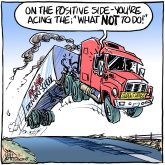Add a few more items to the list of things Prairie grain farmers should worry about as they go about their business of taking off the second-last crop of the 20th Century.
To the traditional list (weather, quality, price and markets) add a few non-traditional items – the value of the Russian ruble, the financial health of Japanese banks, the outcome of the current political struggle in Moscow.
Last week’s hike in Canadian interest rates was directly connected to fallout from the Russian financial crisis. Money traders rushed to the U.S. dollar.
Read Also

Rural communities can be a fishbowl for politicians, reporter
Western Producer reporter draws comparisons between urban and rural journalism and governance
Other currencies, including the Canadian dollar, lost value. To boost the dollar, the Bank of Canada announced an interest-rate increase. Tens of thousands of farmers could feel the impact through higher debt-servicing costs.
It is the weird and interconnected world that the traders and financiers have built for us. Of course, export-dependent farmers always have understood their fate was linked to international events.
But more often than not, it was at least easy enough to understand the link. Not so long ago, for example, Prairie farmers paid close attention to weather patterns in the Soviet Union.
Bad weather in the hinterland meant the U.S.S.R. likely would be importing more grain. The connection between the farmer in the combine on the Regina Plains and the consumers of Russia was traditional and easy enough to understand. Canada produced a surplus of grain. The Soviet Union often did not, but could afford to buy it.
These days, a connection between the two worlds still exists but it is far more complex than it once was, almost perverse. And it is based more on perception and expectation than on reality.
Russia, no longer the Soviet Union and no longer a superpower, no longer buys Canadian grain.
It cannot even create the conditions to ensure its people are fed.
With an economy just a fraction of the size of Canada’s, Russia hardly looks like a country whose instability could throw the world into turmoil and impose costs on Prairie farmers.
Its influence lies in the fact that western bankers, investors and governments have put a lot of emphasis on proving that capitalism can bloom in a country which once epitomized communism.
They lent billions of dollars, built up expectations, talked endlessly about the “progress” Russia has made and chirped proudly about the wealth being generated. Of course, behind the facade of instant millionaires and Moscow hotels jammed with westerners hoping to invest, there was a grim reality.
The state was collapsing. The economy was not working. The new “wealth” was not filtering down to average people.
In a decade, Russia slid from the status of stagnant communist superpower to Third World capitalist quagmire.
That now-obvious reality has sent the agents of capitalism and their investment dollars scurrying to the safer ground of the American currency.
Canadians who must borrow or who live with floating interest rates are among the millions worldwide who pay the price.














